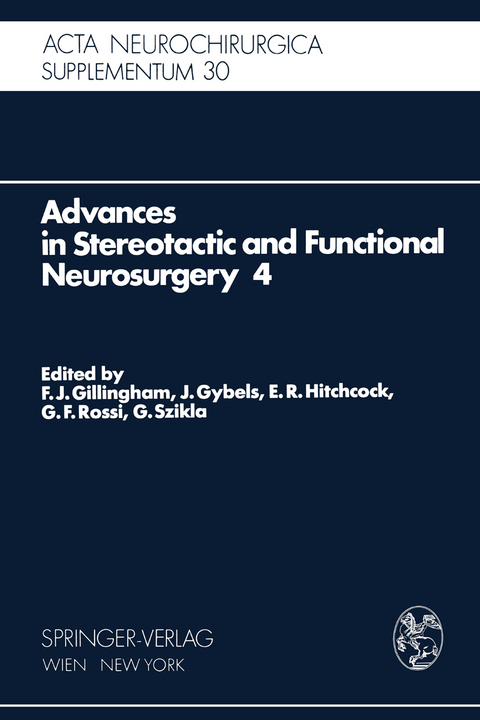
Advances in Stereotactic and Functional Neurosurgery 4
Springer Wien (Verlag)
978-3-211-81591-5 (ISBN)
Target Point, Target Volume, "Whole Brain" Stereotaxis: Remarks on Some Present Trends of Evolution in Stereotactic Neurosurgery.- Section I. Surgery of Epilepsy A. Introduction.- Why, When, and How Surgery of Epilepsy?.- B. Reports.- Surgical Aspects of Temporal Lobe Epilepsy. Results and Problems.- Surgery of Epilepsy Based on Stereotactic Investigations-the Plan of the SEEG Investigation.- Application of Stereotactic Concepts to the Surgery of Epilepsy.- Long Term Results of Cortical Excisions Based on Stereotactic Investigations in Severe, Drug Resistant Epilepsies.- Surgical Interruption of the Conduction Pathways for the Control of Intractable Epilepsy.- From Experiences of Medial Amygdalotomy on Epileptics.- Neurophysiological Remarks.- C. Communications.- Burr-Hole Electrocorticography.- Differential Diagnosis Between Temporal and "Perisylvian" Epilepsy in a Surgical Perspective.- Clinical and Chrono- topographic Psydiomotor Seizure Patterns (SEEG Study with Reference to Postoperative Results).- Stereo-EEG and Surgery in Partial Epilepsy with Temporo-Parieto-Occipital Foci.- Relationship Between the Location and Delimitation of the Epileptogenic Zone and Surgical Results. A Report of 24 Patients Operated on Using the Technique Described by J. Talairach et al.- Medically Intractable Epilepsies of Tumoural Aetiology. Report of 4 Cases Treated According to the Method Described by J. Talairach et al.- Anterior Callosotomy in Epileptics with Multiform Seizures and Bilateral Synchronous Spike and Wave EEG Pattern.- Anterior Callosotomy as a Substitute for Hemispherectomy.- Late Results of Stereotactic Radiofrequency Lesions in Epilepsy.- Stereotactic Lesions in Primary Epilepsy of the Limbic System.- The Effect of Medial Amygdalotomy and AnteriorHippocampotomy on Behavior and Seizures in Epileptic Patients.- Memory and Learning in Epileptic Patients Treated by Amygdalotomy and Anterior Hippocampotomy.- Slowing of Scalp EEG After Electrical Stimulation of Amygdala in Man.- Central Stimulation Treatment of Epilepsy.- D. Closure.- Closing Remarks.- Section II. Stereotactic Cerebral Irradiation.- Some Comments on the INSERM Symposium on Stereotactic. Cerebral Irradiations Held Friday, July 13, 1979.- Section III. Neurostimulation for Pain and Spasticity A. Pain.- Analgesia Induced by Electrical Stimulation of the Brain Stem in Animals: Involvement of Serotoninergic Mechanisms.- The Current Status of Analgesie Brain Stimulation.- Biochemistry of Pain Relief with Intracerebral Stimulation. Few Facts and Many Hypotheses.- Control of Dyskinesias Due to Sensory Deafferentation by Means of Thalamic Stimulation.- Deep Brain Stimulation in Mesencephalic Lemniscus Medialis for Chronic Pain.- Electrical Stimulation of the Central Gray for Pain Relief in Human: Autopsy Data.- Indications and Ethical Considerations of Deep Brain Stimulation.- Septal Stimulation on Painful and Symbolic Stress. Experimental Study.- A Study on the Tridimensional Distribution of Somatosensory Evoked Responses in Human Thalamus to Aid the Placement of Stimulating Electrodes for Treatment of Pain.- Deep Brain Stimulation for Severe, Chronic Pain.- Chronic Self-Stimulation of the Medial Posterior Inferior Thalamus for the Alleviation of Deafferentation Pain.- Alleviation of Atypical Trigeminal Pain by Stimulation of the Gasserian Ganglion via an Implanted Electrode.- Stimulation of Conus-Epiconus with Pisces. Further Indications.- B. Spasticity.- Chronic Cerebellar Stimulation for Cerebral Palsy-Five-Year Study.- Side Effects and Long-Term Resultsof Chronic Cerebellar Stimulation in Man.- Correlation of Clinical and Physiological Effects of Cerebellar Stimulation.- Stereotactic Approadi to Therapeutic Stimulation of Cerebellum for Spasticity.- Chronic Self-Stimulation of the Dentate Nucleus for the Relief of Spasticity.- Section IV. Advances and New Techniques.- Experimental Percutaneous Approach to the Trigeminal Ganglion in Dogs with Histopathological Evaluation of Radio- frequency Lesions.- Stereotaxic Aspects of Percutaneous Trigeminal Gangliolysis.- The Effectiveness of Trigeminal Thermocoagulation for Recurrent Paroxysmal Trigeminal Neuralgia After Previous Intra-Cranial Surgery.- First Results with Extralemniscal Myelotomy.- Pain Relief After Dorsal Root Entry Zone Lesions.- Rostrai Mesencephalic Reticulotomy for Pain Relief. Report of 15 Cases.- Stereotactic Lesions Studied by Computer Tomography.- Long Term Effects of Stereotaxic Thalamotomy on Parameters of Cognitive Functioning.- Stereotaxic Clipping of Arterial and Arteriovenous Aneurysms of the Brain.- Combined Approach (Stereotactic-Microsurgical) to a Paraventricular Arteriovenous Malformation. Case Report.- Investigations Concerning Motor Control in Patients Suffering from Various Lesions of Sensory- Motor Systems.- Evoked Responses by Physiological Sensory Inputs in Human Central Motor Structures.- Pisces Stimulation for Motor Neurone Disease.- Long-Term Results of Posterior Functional Rhizotomy.- Intraneoplastic Administration of Bleomycin in Intracerebral Gliomas: A Pilot Study.
| Erscheint lt. Verlag | 28.11.1980 |
|---|---|
| Reihe/Serie | Acta Neurochirurgica Supplement | Advances in Stereotactic and Functional Neurosurgery |
| Zusatzinfo | VIII, 444 p. |
| Verlagsort | Vienna |
| Sprache | englisch |
| Maße | 152 x 229 mm |
| Gewicht | 870 g |
| Themenwelt | Medizinische Fachgebiete ► Chirurgie ► Neurochirurgie |
| Schlagworte | Aneurysm • brain • Epilepsy • Glioma • neurosurgery • Surgery • Tomography |
| ISBN-10 | 3-211-81591-0 / 3211815910 |
| ISBN-13 | 978-3-211-81591-5 / 9783211815915 |
| Zustand | Neuware |
| Informationen gemäß Produktsicherheitsverordnung (GPSR) | |
| Haben Sie eine Frage zum Produkt? |
aus dem Bereich


